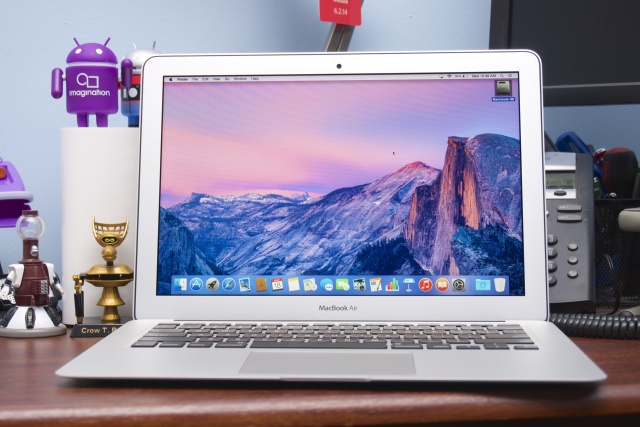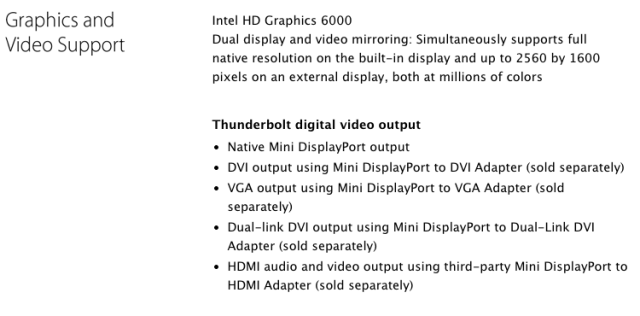
When the new MacBook Pros and Airs were announced, we reported that both systems were capable of driving 4K displays at a refresh rate of 60Hz. In our head-to-head comparison of the two systems, we did it again. But in the last few days a number of readers have pointed out that Apple’s tech specs page for the new MacBook Airs claims a maximum resolution of 2560×1600.

We were fairly sure that Apple’s spec page was incorrect, but to get a definitive answer we dove into the still-nascent 4K display ecosystem to do some testing. The short answer is that yes, both the Pros and Airs now support 4K output at 60Hz using a single DisplayPort 1.2 cable. Last year’s Air connected to the same display with the same cable can manage, at best, a blurry 2560×1440.
That’s because unlike last year’s Airs and 13-inch Pro (and all older DisplayPort and Thunderbolt Macs), the new versions of the laptops have the correct combination of hardware that makes 60Hz 4K output possible. Intel’s documentation tells us that the new Broadwell-U processors and their integrated GPUs support output of up to 3840×2160 at 60Hz when connected using DisplayPort 1.2, where the Haswell versions were capped at 30Hz (4K over HDMI remains capped at 24Hz, a limitation of the HDMI 1.4 spec). Both Airs and the Pro had also made the jump to Thunderbolt 2, which explicitly supports DisplayPort 1.2.
If you’re a 2015 MacBook Air owner looking for more information about buying a 4K display, here’s what we can tell you.
Choosing a monitor

Until pretty recently, trying to find a 4K display that didn’t cost an arm and a leg was truly a pain, doubly so if you insisted on 60Hz (this is the refresh rate you’re used to seeing in essentially all screens today; stepping down to 30Hz can be tolerated, but it will often appear somewhat laggy or jerky). Many monitors pulled off 4K by treating each half of the monitor as its own display, stitching them together using hardware or software to make one picture with varying degrees of success. This is sometimes referred to as MST, or Multi-Stream Transport.
While the DisplayPort 1.2 spec allows multiple DisplayPort streams to be sent over a single cable, using two video streams in this way does cut down on the number of monitors you can have attached to your system. If a given GPU can support a total of four displays, for example, using an MST connection eats up two streams and limits you to a total of three displays. Using a single video stream (SST, or Single Stream Transport) is a cleaner solution, and luckily 60Hz 4K SST monitors are becoming more common and less expensive.
Our choice, Dell’s 24-inch P2415Q, has only been on the market since December, and since then they’ve fallen from an MSRP of $600 to just south of $500. That’s not drastically more expensive than something like the well-regarded U2412M, which usually goes for around $300.
We’re not really equipped to review monitors here; my professional opinion of this one is “it’s very nice.”
We picked it because of its desk-friendly 24-inch size, because its stand will do all the tilting and pivoting that you’d ever need it to, and because it has a nice array of ports: an MHL-compatible HDMI-out, both full-size and Mini DisplayPort inputs, a four-port USB 3.0 hub, and a DisplayPort output for daisy-chaining. Dell offers better displays if you need a pro-level color gamut, but it’s an IPS panel that covers 99 percent of the sRGB color space, so it will look great to most eyes. 4K is still far from a mainstream feature, but monitors like this one are as close as it’s ever been.
4K monitor, meet integrated GPU

Despite what Apple’s spec page currently says, connecting the 2015 Air to the P2415Q worked perfectly. The Mac detected the display, noticed that it was 4K, and without any extra cajoling began displaying in HiDPI mode. You get the same usable screen space as a standard 1080p display, just with sharper images and text. The BlurBusters refresh rate test verified that we were looking at 60Hz output.
Given that the Air is using one of Intel’s integrated GPUs, general OS X user interface performance isn’t too bad while driving the Air’s internal display alongside the 4K display. Dropped frames are clearly visible when entering into Full Screen mode or using Mission Control, and of course you’ll never want to try playing games or doing heavy 3D work at native resolution. But things are more than smooth enough for desktop use.
Scale the display up and things become less pleasant. If you use a Retina MacBook of some kind, you already know that OS X can scale its display to give you more usable screen space. It accomplishes this by drawing a larger 4608×2592, 5120×2880, or 6016×3384 image and scaling it down to fit the 3840×2160 resolution of the display. Naturally, this is much more taxing on the GPU, and the higher you go the jerkier the animations become. By the time you’re drawing a 5120×2880 image, transitions become flipbooks, and occasionally you won’t see any transitional animations at all. It’s still mostly OK while you’re not looking at sweeping animations, but even scrolling performance takes a small hit here.
So there you have it: the new MacBook Air definitely supports 4K displays at 60Hz in SST mode, and it actually supports them fairly well if you’re not using OS X’s scaling functions. We’ve informed Apple about the issue, and hopefully the specs pages will be updated accordingly. In the meantime, if you were considering an Air for its 4K support but weren’t sure whether to believe Apple’s specs page, now you have your answer.
Update: As of April 1, Apple has updated the MacBook Air's spec page to confirm its 4K support.

Listing image by Andrew Cunningham
reader comments
51